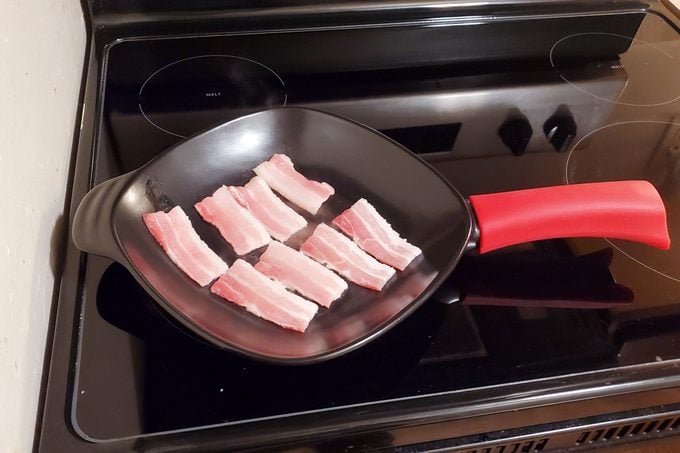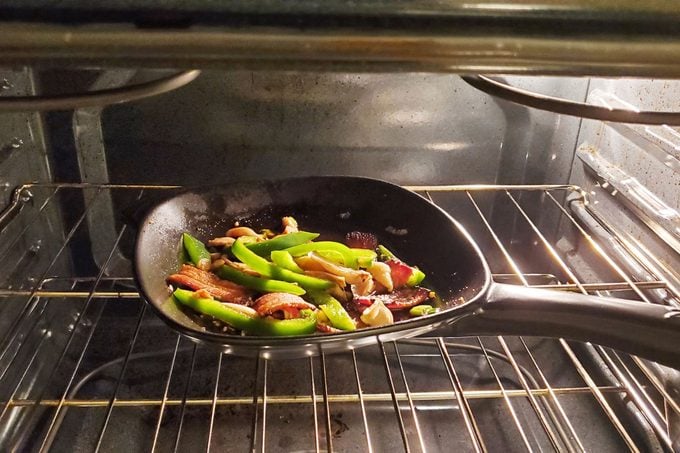Xtrema Ceramic Cookware Review: How Does it Perform Against Ceramic-Coated Options?
Updated: Jul. 27, 2024
What is fully ceramic cookware, and how does it differ from ceramic-coated pans? Our Shopping Editor put the 100% ceramic Xtrema ceramic cookware to the test—here's what she learned.
Our editors and experts handpick every product we feature. We may earn a commission from your purchases.Learn more.

While I appreciate sliding an egg right off of my pan onto a plate, all this recent talk of PFAS and forever chemicals has made me question whether my nonstick cookware is safe. For folks like me who have been using the same Teflon-coated pans for close to a decade, it’s time to upgrade. But when it comes to cookware, there are tons of different types to consider. Between stainless steel, cast iron and ceramic, finding the best kind of frying pan feels like an endless struggle of trying and failing. At least, before I found Xtrema ceramic cookware.
What is the Xtrema frying pan?
 TMB STUDIO
TMB STUDIO
We Tried It
Xtrema Ceramic Frying Pan
This 9.5-inch ceramic frying pan will quickly become the one you reach for most around meal time.
Xtrema makes safe, reliable cookware that doesn’t contain harmful forever chemicals like PFAS. Unlike ceramic-coated cookware like the internet-famous Always Pan, GreenPan or Caraway cookware, Xtrema uses only ceramic in the construction of their cookware. That means that there’s no steel core or ceramic coating—just one piece of kiln-fired ceramic forms the entire pan, including the handle.
They have a huge range of different types of pans, from deep skillets for frying up chicken to woks, stock pots and Dutch ovens. Xtrema even offers a few other fun finds, like tea kettles and baking sheets—all fully crafted from ceramic.
The Traditions frying pan is one of Xtrema’s most popular pans. And right now, it’s on sale for 15 percent off. In addition to the fully ceramic construction, unique flared edges make sliding food from pan to plate a cinch. A wide base, dishwasher and microwave-safe materials and a glossy, scratch-free surface immediately caught my attention. I had to have one!
How does ceramic-coated cookware differ from fully-ceramic cookware?
As outlined in Taste of Home’s frying pan guide, there are several benefits to opting for ceramic cookware, like zero chemical coatings and a stick-free surface. It’s also lightweight. How does ceramic-coated cookware differ from fully ceramic pans, like those from Xtrema? Being just a humble home cook, I spoke with Taste of Home’s own Executive Culinary Director, Sarah Farmer, to get her take.
“I haven’t (yet!) used Xtrema or any other brand of 100% pure ceramic cookware, but I know this is an entirely different animal than the very popular ceramic-coated cookware,” Sarah says. “The main difference between the two is that pure ceramic cookware doesn’t contain any metal. It’s made solely from clay and other elements from the earth. This type of cookware, which is one solid piece of material, is formed, fired in a kiln and finished with a glaze that gives it a smooth, non-porous and somewhat naturally non-stick surface.”
She notes that, unlike Xtrema’s fully ceramic pans, ceramic-coated cookware’s nonstick properties don’t diminish over time. Instead, ceramic-coated cookware “is comprised of a metal base (usually aluminum) with a layer of non-stick ceramic coating. It’s marvelously non-stick in the beginning and eggs will fling freely from it. But over time, the coating diminishes, eventually exposing the metal base and food will start to stick.
Fully ceramic cookware is scratch-resistant and when used properly, can last for years and years. Because it retains heat longer than ceramic-coated cookware, I’d use it for soups and any number of stovetop recipes where I want to maintain the temperature. I love the versatility of fully ceramic cookware, too.
What’s important to me with cookware is not just overall performance, but durability. I would rather have fewer quality pieces that do what I need them to do and hold up to my cooking vs. many pieces that might only work well in certain cooking applications and have a limited lifespan. Looking at the differences between the two main types of ceramic cookware, pure ceramic and ceramic-coated—for the long haul, I’m going with the former.”
How We Tested the Traditions Frying Pan

I had some fresh pork belly from the local Asian market—a perfect way to break in the new pan. First, I heated up the pan to medium-high heat. The pan heats up reasonably fast—though not as quickly as my nonstick pans. I used Taste of Home‘s shoyu ramen recipe to assemble the sauce for my pork belly pieces, then set about arranging a few quarter-inch thick slices on the preheated Xtrema frying pan.
It was instantly clear that the pan had heated evenly, even around the flared edges. It took no time at all to brown up one side of the pork belly slices. After about three minutes of cooking, I flipped them over. Despite the high heat and lack of oil, the pork’s rendered fat proved enough to prevent any sticking. I was shocked! Plus, the flared edges offered my stovetop protection from splatters.
After cooking up the last of the pork, I drained the fat from the pan using the flared edge. Then, I added the sauce to my pork. Despite being off the heat for several minutes at this point, the pan was still hot enough to start boiling the sauce. Sarah is right—fully ceramic cookware is definitely the best choice for heat retention.
While I used my Instant Pot to cook some rice, I decided to add a few vegetables like chopped Napa cabbage and slices of green peppers to the sauced pork. To warm the veggies through, I decided to test the pan’s effectiveness in the oven. Thankfully, the pan came with a handy silicone sleeve for the handle. It made relocating the hot pan to my top oven rack easy.
The result? A delicious, sticky and crispy pork belly dish with crisp, warm veggies. The Xtrema ceramic cookware frying pan is my new go-to for stove-to-oven dishes. I love how easy it is to maneuver around the kitchen when compared to my heavy cast iron skillet. I worried that the sticky sauce would prove to be too much for my poor pan. To my surprise, it wiped down easily with a sponge after rinsing. Amazing!
I highly recommend using enough oil or fat when cooking. In addition, wait until the pan is at your desired temperature (Xtrema recommends keeping temps at low to medium) before adding ingredients to fully enjoy the nonstick properties. Otherwise, you may end up scraping off stuck-on egg when it’s time to clean up.
Product Testing Team’s Evaluation

Our Product Testing Team has ample experience testing everything from the best toasters to the best food processors, so we enlisted their help to find the best cookware of every type. We re-tested Caraway ceramic cookware to see how it compares to competitors’ ceramic cookware, using a sliding egg test (with and without oil), a searing test with chicken tenderloin and a crepe test to determine how evenly it cooks. In the Product Testing Team’s evaluation, they loved that there’s no coating that can erode over time or rivets that make cleaning difficult. While it doesn’t get high marks for its nonstick properties, it does impress with its heirloom-quality construction and microwave-safe features.
“If you’re looking for non-stick ceramic cookware, this isn’t your best choice. But if you want to be assured you’re purchasing a non-toxic pan, Xtrema is worth checking out,” says Product Testing Team Member Dylan Fischer.
Pros
- Fast, even heating
- Very little sticking, provided cooks use enough fat
- Good amount of browning, comparable to cast iron
- Amazing heat retention
- Flared edge catches splatters
- Oven, microwave and dishwasher-safe
- Works on nearly all heat sources, including over a fire and on a grill
Cons
- Some sticking if not heated up or oiled properly
- Can’t use metal utensils
- Not compatible with induction cooktops
- Ceramic is fragile and will definitely break if dropped
FAQ
Can Xtrema cookware go in the oven?

Absolutely! As Sarah says, fully ceramic cookware, like cast iron, is compatible with all heating sources (except for induction since there’s no metal, which is required for heat transfer). “It’s even okay to put it under the broiler. Heck, you can set this right on the grill if you’d like,” she says.
What is the healthiest cookware to use?
Stainless steel, cast iron and ceramic are widely regarded as the healthiest types of cookware. These materials are free from potentially toxic nonstick coatings, are more resistant to scratches and can withstand repeated cleaning.
Can you use metal utensils on Xtrema cookware?
Xtrema does not recommend using metal kitchen utensils with their cookware. While metal cannot scratch the cookware’s surface, it can leave metal marks that may be difficult to remove. Instead, opt for silicone or wood cooking utensils.
What Other Reviewers Had to Say
Like me, reviewers can’t get enough of the flared edges and toxic-free materials baked into Xtrema ceramic cookware. “This skillet has a design I had never seen before,” one reviewer writes, “While I didn’t think I ‘needed’ it, something told me to grab one when it was on sale. I am so glad that I did! I like to save my bacon grease and this has made pouring it out without a mess so much easier! It makes awesome eggs, pancakes and French toast and is also great to sauté veggies in. I love the flavors so much more when I use this skillet! Highly recommend!”
The Final Verdict
The Xtrema frying pan is my first foray into the world of fully ceramic cookware, and I’m thoroughly impressed! While it doesn’t offer the same zero-stick properties as ceramic-coated or nonstick cookware (which it doesn’t claim to), the heat retention, durability and scratch-free surface make up for that.
Despite a small learning curve, when used properly, the Xtrema Traditions frying pan doesn’t require aggressive scrubbing to clean. It delivers delicious, toxin-free meals and the oven-safe feature is amazing for braising and warming up dishes. I plan to pick up some more Xtrema ceramic cookware soon.
Where to Buy the Xtrema Frying Pan
 TMB STUDIO
TMB STUDIO
We Tried It
Xtrema Ceramic Frying Pan
Lightweight, yet durable, this ceramic frying pan is dishwasher safe and 100% non-toxic.
Head over to Xtrema’s website to secure your own Traditions pan. Currently, Xtrema is offering up to 15 percent off, plus free shipping on orders over $200. Now is the best time to secure the heirloom-quality Xtrema frying pan for under $150.
Why You Should Trust Us
Emily Way, the author of this piece, is a shopping editor with two years of experience contributing to Reader’s Digest, Taste of Home, and Family Handyman. She has tested and reviewed more than 100 food, lifestyle, DIY and sleep products and penned Black Friday sales guides two years in a row. She has covered everything from brand launches to pizza ovens. For this piece, she sought the expertise of Taste of Home’s Executive Culinary Director, Sarah Farmer.




















